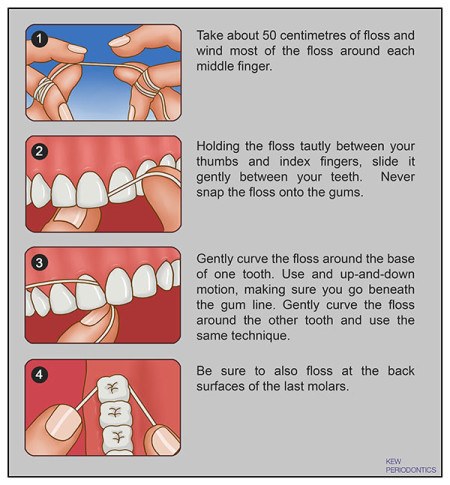
Flossing is essential for oral hygiene, yet often overlooked or done incorrectly. To floss effectively, start with about 18 inches of floss and wrap it around your middle fingers. Glide the floss between each tooth, curving it in a C-shape around the base of each tooth. This removes plaque and debris, preventing cavities and gum disease. Thorough flossing also promotes a healthy smile. By mastering proper flossing technique, you can maintain optimal oral health and keep your pearly whites shining bright. So, next time you floss, remember these tips for a thorough clean and a radiant smile.

How to Floss Your Teeth Effectively
Flossing your teeth is an essential part of maintaining good oral hygiene. While brushing alone can clean the surfaces of your teeth, flossing helps remove plaque and food particles from the tight spaces between your teeth and along the gumline. However, many people struggle with flossing correctly, which can diminish its effectiveness. In this article, we will discuss the proper technique for flossing your teeth effectively and highlight some tips and tricks to make the process easier.
The Importance of Flossing
Flossing plays a crucial role in preventing tooth decay and gum disease. When you brush your teeth, you may not be able to reach the areas where your teeth are tightly packed together. These spaces provide the perfect hiding spot for plaque and bacteria, which can lead to cavities and gum inflammation. Regular flossing helps remove this buildup, reducing your risk of dental problems in the long run.
To floss your teeth effectively, follow these steps:
1. Start with a piece of dental floss that is about 18 inches long. Wrap the ends around your middle fingers, leaving a few inches of floss to work with.
2. Hold the floss tightly between your thumbs and index fingers, leaving about 1-2 inches of floss in between. Gently slide the floss between your teeth using a back-and-forth motion.
3. Curve the floss around the base of each tooth, making a C-shape. Gently move the floss up and down to remove plaque and debris.
4. Use a fresh section of floss for each tooth. Be sure to clean both sides of every tooth, including the back molars.
5. As you move from tooth to tooth, unwind the used floss from one hand and wind the clean floss onto the other hand.
Common Mistakes to Avoid
While flossing seems straightforward, many people make common mistakes that can undermine its effectiveness. Here are some errors to avoid:
1. Snapping the floss: Instead of forcefully snapping the floss between your teeth, use a gentle sliding motion. Snapping the floss can injure your gums and cause discomfort.
2. Skipping the gumline: Make sure to guide the floss along the gumline of each tooth. Plaque buildup in this area can lead to gum disease, so it’s crucial to clean it properly.
3. Rushing the process: Take your time when flossing and give each tooth the attention it deserves. Rushing can lead to inadequate cleaning and leave behind harmful bacteria.
4. Using too little floss: Make sure to use enough floss to reach all the crevices between your teeth. Insufficient floss can prevent you from effectively cleaning those hard-to-reach areas.
Tips for Easier Flossing
Flossing can be challenging, especially if you have dexterity issues or tight spaces between your teeth. Here are some tips to make the process easier:
1. Try different types of floss: If you struggle with traditional floss, consider using alternative options such as floss picks, pre-threaded flossers, or water flossers. These tools can provide additional convenience and ease of use.
2. Use waxed floss: Waxed floss slides more easily between your teeth, making it ideal for individuals with tight spaces or braces.
3. Use a threader if needed: There ae dental flosses that come with a threaders for easier insertion of the flossing thread.
4. Be consistent: Make flossing a daily habit to ensure optimal oral health. Consistency is key when it comes to maintaining a healthy smile.
5. Seek professional advice: If you’re unsure about the proper flossing technique or have specific concerns, consult your dentist or dental hygienist. They can provide personalized guidance and address any questions you may have.
In conclusion, flossing your teeth effectively is essential for maintaining good oral health. By following the proper technique, avoiding common mistakes, and incorporating helpful tips, you can ensure that your flossing routine is both effective and efficient. Remember, consistency and attention to detail are key when it comes to achieving optimal oral hygiene. So, make flossing a part of your daily routine and enjoy the benefits of a healthy smile.
Key Takeaways: How to Floss Your Teeth Effectively
- Make sure to use a piece of floss about 18 inches long.
- Wrap the floss around your fingers, leaving a small section to work with.
- Gently slide the floss between your teeth, using a back-and-forth motion.
- Curve the floss around each tooth, reaching below the gumline.
- Be sure to floss between all of your teeth, including the back ones.
Frequently Asked Questions
Here are some commonly asked questions about how to floss your teeth effectively:
1. Why is flossing important for oral health?
Flossing plays a crucial role in maintaining good oral health. While brushing cleans the surfaces of your teeth, flossing helps remove plaque and food particles from the spaces between your teeth and along the gumline. This prevents the buildup of bacteria that can lead to gum disease, tooth decay, and bad breath.
Regular flossing also helps to stimulate the gums, promoting healthy gum tissue and reducing the risk of gum inflammation or bleeding. By incorporating flossing into your daily oral care routine, you can greatly improve the overall health of your teeth and gums.
2. How often should I floss my teeth?
It is recommended to floss your teeth at least once a day. This ensures that you are effectively removing any plaque or debris that may have accumulated throughout the day. Flossing before bedtime is especially important, as it helps to remove any food particles that could potentially cause overnight bacteria growth.
If you have braces, dental implants, or other dental appliances, you may need to floss more frequently to ensure proper oral hygiene. Your dentist or orthodontist can provide specific guidance on the best flossing routine for your individual needs.
3. What is the correct technique for flossing?
To floss your teeth effectively, start by breaking off about 18 inches of floss. Wind the majority of the floss around your middle fingers, leaving about 1-2 inches of floss to work with. Hold the floss tightly between your thumbs and index fingers, and gently guide it between your teeth using a back-and-forth sawing motion.
Once the floss reaches the gumline, curve it into a C-shape against one tooth and slide it gently beneath the gumline. Then, slide the floss up and down against the tooth surface, making sure to clean both sides. Repeat this process for each tooth, using a fresh section of floss for each gap.
4. Can I use alternatives to traditional dental floss?
Yes, there are alternatives to traditional dental floss that can be effective in cleaning between your teeth. Dental floss picks, which have a small piece of floss threaded onto a handle, can be convenient for those who find it difficult to maneuver regular floss. Water flossers, which use a stream of water to clean between teeth, can also be a useful tool.
However, it’s important to note that these alternatives should not replace regular flossing entirely. They can be used as a supplement, but traditional flossing is still considered the most effective method for removing plaque and debris from the teeth and gums.
5. Are there any tips for making flossing more comfortable?
If you find flossing uncomfortable or difficult, there are a few tips that can help. First, try using a waxed floss, as it tends to glide more smoothly between teeth. You can also try using floss holders or flossing aids to make the process easier.
If you have sensitive gums, be gentle when flossing and avoid snapping the floss against the gums. If you experience bleeding or persistent discomfort while flossing, it’s important to consult with your dentist, as it could be a sign of gum disease or other oral health issues.
Dental Hygienist TEACHES How To Floss
Final Summary: Mastering the Art of Effective Teeth Flossing
In our busy lives, dental care often gets overlooked, but flossing is essential for oral health. Learn the correct technique and choose the right tools for effective flossing. Be thorough and consistent to prevent plaque buildup and protect your teeth. With dedication, you’ll maintain a healthy, radiant smile for years to come.
Call or Book appointment online
:Ace Dental Care Alpharetta office: 678-562-1555 - Book Now
Ace Dental Care Norcross office: 770-806-1255 - Book Now
Disclaimer
This blog post was generated by artificial intelligence. The content of this post may not be accurate or complete, and should not be relied upon as a substitute for professional advice. If you have any questions about the content of this post, please contact us.
We are constantly working to improve the accuracy and quality of our AI-generated content. However, there may still be errors or inaccuracies. We apologize for any inconvenience this may cause.





